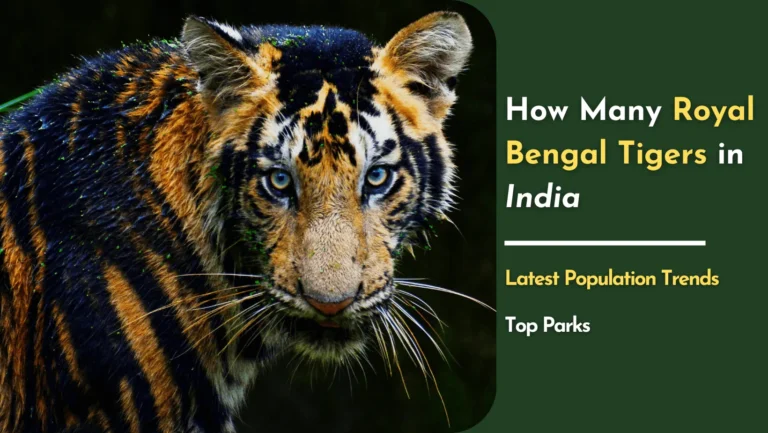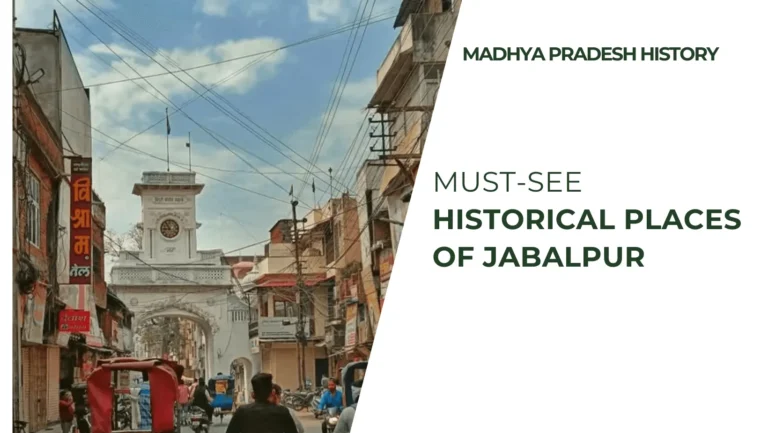Budget Stay Starting @ ₹500 to ₹1000 in Jabalpur
How to Find Royal Bengal Tigers in Their Natural Habitat in Madhya Pradesh?


Quick Facts About Royal Bengal Tiger
The Royal Bengal Tiger is an awe-inspiring predator of the wild, celebrated for its strength and magnificence. Found primarily in India, Nepal, Bhutan, Bangladesh, and parts of Myanmar and southern Tibet, this subspecies is an integral part of the tiger family. A fully grown Royal Bengal Tiger weighs between 140 to 190 kg (310 to 420 pounds) and measures up to 9 feet in length, including its tail. Standing at an impressive 3 to 3.6 feet in height, these tigers are apex predators with astounding physical capabilities.1
Known for their sharp canines, which measure up to 4 inches in length, they possess extraordinary jaw strength, making them efficient hunters. Their iconic striped coat provides effective camouflage in the dry forests of their habitat, such as those in Madhya Pradesh. The Royal Bengal Tiger is a solitary creature, typically coming together only during mating season. Each tiger maintains a vast territory, patrolling it with precision.
Their diet includes antelope, wild boar, deer, and water buffaloes, consuming up to 30-40 kg of meat in a single meal. This feast sustains them for weeks. Madhya Pradesh, home to several Royal Bengal Tiger national parks like Bandhavgarh and Kanha, plays a critical role in conservation efforts. Despite being endangered, with fewer than 4,000 remaining globally, these efforts have provided hope for their survival.2
Why Madhya Pradesh is a Prime Destination for Spotting Royal Bengal Tigers?
Madhya Pradesh is the tiger haven of India. Out of 3,925 tiger population the India MP tops the list with 785 tigers with the highest tiger population in any state followed by Karnataka with a big margin of 563 tigers. [ref] MP has received the most fruits for its efforts in Tiger Conservative. Below are the top parks where you can see the magnificent creatures.3
Bandhavgarh National Park: The Highest Tiger Density in India
Bandhavgarh National Park is a premier destination for tiger safaris in Madhya Pradesh, ranking second only to Jim Corbett National Park nationally. Nestled in the Vindhya hills, this park offers a unique habitat of caves and hills, ideal for sustaining the thriving population of Royal Bengal Tigers in Madhya Pradesh. The core area of the park spans 105 sq km, while the buffer zone covers approximately 400 sq km. The park’s diverse topography includes steep ridges, dense forests, and open meadows, making it a breathtaking landscape for wildlife enthusiasts.
Bandhavgarh is also home to the elusive white tiger, adding to its appeal. Established as a national park in 1968, it has three major zones: Tala, Magdi, and Bamera. Among these, Tala is the most popular, offering frequent tiger sightings, while Magdi provides tourists the unique opportunity to spot tigers from elephant-back safaris. This makes Bandhavgarh a must-visit for tiger lovers.
Beyond tigers, visitors can explore the ancient Bandhavgarh Fort and the historic Seesh Shaiya, adding cultural value to the safari experience. The best time to visit is from February to June or October to December, as the park remains closed from July 1 to October 15 during the monsoon.
For more information visit: https://bandhavgarh-national-park.com/.
Kanha National Park: A Sanctuary for Tigers
Kanha National Park, located in the Maikal range of the Satpuras in Madhya Pradesh, is the second closest tiger destination near Jabalpur. Situated in the Mandla district, Kanha was declared a national park in 1955. Spanning 940 sq km with an additional buffer area of 1,945 sq km, it is one of the largest and most picturesque forests in India. The dense terrain of Kanha has inspired Rudyard Kipling’s famous creation, The Jungle Book.
Kanha National Park is renowned for being a prime habitat for the majestic Royal Bengal Tiger in Madhya Pradesh, making it a sought-after destination for wildlife enthusiasts. Besides tigers, the park is home to a wide variety of fauna, including the endangered Barasingha (Swamp Deer), often referred to as the “Jewel of Kanha,” and several other animals like leopards, sloth bears, and wild dogs.
The park is divided into six zones: Kanha, Kisli, Sarhi, Mukki, Bhaisanghat, and Supkhar. Visitors can book a jeep safari to explore these zones, with both morning and afternoon shifts available. Kanha remains open for tourists from October 16 to June 30, offering a perfect opportunity to witness the incredible wildlife, including the Royal Bengal Tiger, in their natural habitat.
For more information visit: https://www.kanha-national-park.com/.
Pench National Park: The Jungle Book’s Real-Life Setting
Pench National Park is a nostalgic journey to your childhood if you’ve ever been captivated by The Jungle Book by Rudyard Kipling. Nestled in Madhya Pradesh, Pench derives its name from the Pench River, which flows through and divides the districts of Seoni and Chhindwara. The park covers a core area of 257 sq km and an expansive buffer zone of 758 sq km, extending into neighboring Maharashtra. Initially declared a wildlife sanctuary in 1965, it attained the status of a national park in 1992.
Pench National Park is renowned for its thriving population of the majestic Royal Bengal Tiger in Madhya Pradesh. Apart from tigers, it hosts a diverse range of wildlife, including jackals, peafowls, sloth bears, Indian leopards, wild boars, striped hyenas, Indian wolves, gaurs, and the rare four-horned antelope.
The park features seven distinct zones: Turia, Karmajhiri, Jamtara, Rukhad, Wolf Sanctuary, Sillari, and Khursapar. Turia is the most popular zone, known for frequent tiger sightings. Pench also stands out by offering an exclusive night safari, adding a unique charm to the wildlife experience.
The safari operates in early morning and evening shifts. The park is open from October to June, with the best time to visit being the winter months of November to January. Monsoon months (July-September) should be avoided as the park remains closed.
For information visit: https://www.penchnationalpark.com/.
Satpura National Park: A Less Crowded Haven for Wildlife Enthusiasts
Satpura Tiger Reserve, located in the serene Satpura mountain range of central India, is a haven for nature and wildlife enthusiasts. Spanning an impressive 2,133.307 sq km, the reserve is part of the Central Highlands ecosystem and lies in the Narmadapuram (Hoshangabad) district of Madhya Pradesh. This stunning reserve also encompasses the picturesque Pachmarhi plateau, a popular tourist destination in itself. The name “Satpura” is derived from the Sanskrit words meaning “Seven Folds” or “Seven Hills,” referencing the undulating hills that form a natural watershed between the Narmada and Tapti Rivers.
The reserve is not just a wildlife sanctuary but also a treasure trove of archaeological significance. Over 50 rock shelters with ancient paintings dating back 1,500 to 10,000 years add historical depth to its scenic beauty.
Satpura Tiger Reserve comprises three regions: Satpura National Park, Bori Wildlife Sanctuary, and Pachmarhi Wildlife Sanctuary. The reserve is divided into six core ranges: Kamti, Bori, Churna, East Pachmarhi, West Pachmarhi, and Matkuli. Key tourist zones include Bheemkund (Churna), Madhai, Mallupura, and Pachmarhi, offering visitors a chance to witness the Royal Bengal Tiger of Madhya Pradesh in its natural habitat. Open from October to June, it is closed during the monsoon season.
For more information visit: https://www.satpuratigerreserve.org/.
Planning Your Tiger Safari in Madhya Pradesh
Planning a trip for a jungle safari doesn’t need to be complicated, especially when you have all the details at your fingertips. When organizing your adventure, prioritize the timing and budget to ensure a seamless experience.
If you’re planning a tiger safari in Madhya Pradesh, starting from Jabalpur is the most convenient option. Jabalpur acts as a gateway to the top national parks, including Bandhavgarh, Kanha, Pench, and Satpura—all located within a 250-300 km radius. For travelers, Jabalpur Airport is well-connected to major cities like Delhi, Mumbai, Kolkata, and Bengaluru. If you’re traveling on a budget, consider staying at Hotel Anand, a highly recommended hotel in Jabalpur under 1000, located in Russel Chowk. With rooms starting at just ₹500 and 24-hour room service, it’s the perfect choice for a comfortable stay while saving money for your safari adventure.
For a fulfilling jungle safari experience, pack these essentials:
- Water bottles to stay hydrated.
- A hat or cap for protection against the sun.
- Binoculars for spotting the majestic Royal Bengal Tiger or other wildlife.
- A camera for capturing memories, but check park-specific guidelines before carrying one.
Finally, research safari timings, jeep rentals, tiger spotting locations, and activity fees before your trip. Thoughtful planning ensures a memorable safari adventure while exploring the majestic wildlife of Madhya Pradesh, especially the royal Bengal tiger.



